In any genre, getting the right tones is important, but nowhere is it more crucial than with metal. Without the right tone, you’re not going to sound “metal” at all, and the balance of the sound will be completely thrown off.
So what’s the answer? How do you get an amp with the right tones that takes up minimal space and is easy to transport? The easiest way is by picking up a combo amp for metal. There are a few brands that have become renowned for their high gain and searing metal tones. We’ll be highlighting the best of them in this KillerGuitarRigs Guide.
When testing these amps, we used the same guitar throughout to keep things fair. In this case, a Fender Jim Root Signature Telecaster. We didn’t use any added distortion and relied solely on the amplifier’s gain and any built-in FX to break up the sound.
Read more about our review process.
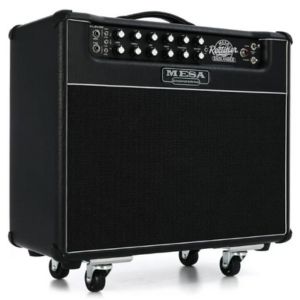
Mesa/Boogie Rectifier Badlander 50-watt Tube Combo
Features: Celestion Creamback speaker, CabClone IR, Includes footswitch
Benefits: Tons of bottom end, Pro grade tones, Huge natural distortion
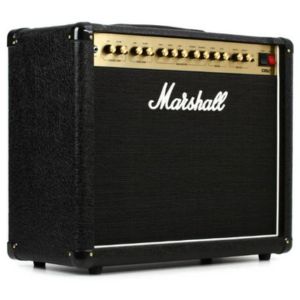
Marshall DSL40CR 1x12" 40-watt Tube Combo Amp
Features: EL34 Power tubes, 2 Channels, Studio grade digital reverb
Benefits: Classic Marshall Crunch, Versatile range of tones, Good portability
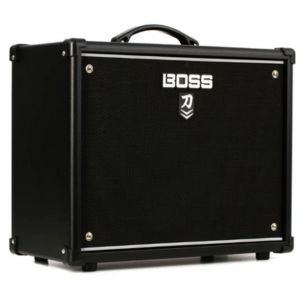
Boss Katana-50 MkII
Features: 5 Amp voicings, 60 Bult in FX, Cab emulated output
Benefits: Tons of huge metal tones, Extremely affordable, Surprisingly loud
Contents
Our Top 3
Our Top Pick was the Marshall DSL40CR. Marshall really nailed it with this one, which is easy to operate, has massive metal tones, handles pedals like nobody’s business, and still offers great value for your money.
Our Best Budget choice was the Boss Katana 50 MKII. We’ve found ourselves coming back to this amp time and time again, but that’s purely because of its versatility. Using Boss’ modeling technology, this Katana can chug like amps literally ten times its price. Budget-conscious shoppers take note!
The Mesa/Boogie Rectifier Badlander 50 was our Editor’s Choice. This is about as good as it gets when it comes to combo amps for metal, offering studio-quality tones and big-stage-ready performance for serious gigging musicians. If you aren’t worried about price, this is the amp for you.
Individual Reviews
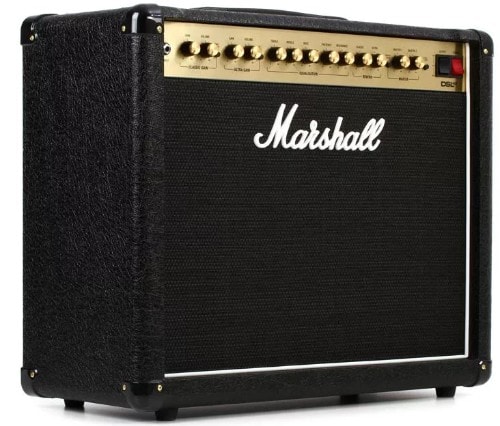
Marshall DSL40CR
A gritty, crunchy behemoth with natural distortion and the headroom to take on pedals
Marshall is one of the most recognizable names in the entire music industry, and they’ve forged their reputation on big, gnarly, crunchy tones, and this combo has all that in spades.
Marshall amps give the archetypal British Sound – dark, gritty, and perfect for metal. The Marshall DSL40CR captures everything the brand is famous for in a convenient combo amplifier that’s ready to chug out of the box (full review here).
Getting to the gain on the DSL40CR is pretty intuitive. The front panel only has one input, but there are two clearly defined channels: Classic Gain and Ultra Gain. For metal tones, Ultra Gain is the setting you want. The Ultra Gain channel features 2 drive modes: OD1, and OD2. We found that OD2 instigated the best distortion out of this amp. We set our EQ with mids at around 10 o’clock and treble and bass at noon, set the gain to max, and we were basically already getting our metal tones. With the gain that high, we were even able to chug at bedroom levels by rolling back the master volume.
The standard speaker is a 12” Celestion V-Type. It worked really well with this setup and complimented the amplifier well. It handles extreme volume without faltering, which is handy considering the enormous volumes this amp is capable of.
This model has 40 watts of all-tube power, making it capable of handling small and medium gigs without the need to plug into FOH. If you want to go direct in, this amp features Softube Speaker Emulated Output, which gives you a number of famous Marshall cabinet models to choose from.
The construction quality is classic Marshall, meaning it’s built like a tank. We found the switchgear and knobs to be top quality, the cabinet was solid, and there were no shakes and rattles, even when pushing all 40 watts through this beast.
Verdict: If you’re looking for an all-tube amp for metal and you value performance as much as price, the Marshall DSL40CR is a stellar choice. It produces some gut-punching metal tones all on its own, but if you want to use pedals, the clean channel has masses of headroom so that it can handle them brilliantly. This is a workhorse of an amp that seasoned pros and amateurs alike will love to have onstage with them.
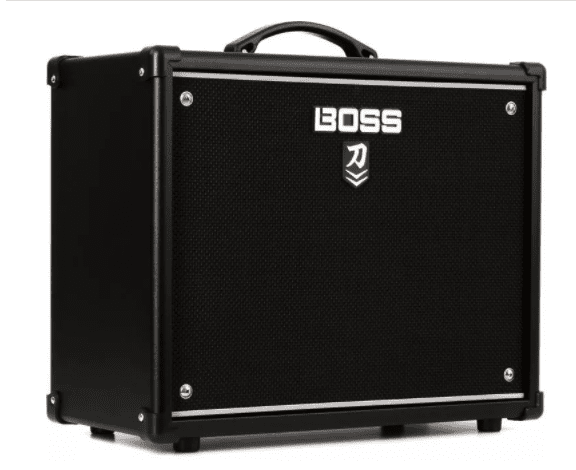
Boss Katana 50 MKII
Perfect tones every time and a price to suit all budgets
This is a unit that consistently appears in top amplifier lists because it’s great at pretty much anything you use it for. It has modeling abilities that far exceed its price point, it’s built well, and in any case, it holds its own with the big guns.
It’s no secret that the KGR team are big fans of the Boss Katana 50 MKII (read our full review), but there’s a good reason for this. Not only does it offer, quite frankly, insane value for money, but it’s one of the most versatile and easy-to-use amplifiers on the market today.
The Katana 50 is a modeling amp, so you’re not relying on knowledge of EQ and gain settings to dial in the perfect metal tone. This is a big part of the appeal of this amp, and others like it, and it’s why we think it’s the best metal amp for beginners in particular.
Using the built-in amp models, we found the best setting for metal was Brown. The folks at Boss don’t always make it particularly clear what their amp models are based upon. To our ears, it closely resembles the tone of the Orange Rockerverb, a legendary amp in the Nu-Metal scene.
The Brown voicing gave us a high-gain metal tone, even with the gain dial set to noon. We dialed it up to full, which gave us even more metal goodness yet still avoided the muddiness that typically plagues budget amps at high gain. There is also a boost function, which we, of course, employed. The boost function ultimately sounds as though you’ve added a tube screamer to the signal path. It still sounded great, although there was just a hint of feedback when the boost was cranked.
After getting a feel for the Katana 50 without FX, we tried out some of the FX, which have recently been updated and expanded in the Boss Tone Studio app (there are now 65 to choose from). The built-in distortion was good, but we actually found it unnecessary, as we managed to get all the breakup we needed purely from the amp voicing, gain dial, and boost.
The Katana 50 gets a single 12” Boss-branded speaker, which performed just as well as some of the big-name brands we encountered in the other amps on test. The versatility of this amp is furthered by the attenuator switch, which lets you switch from the full 50 watts down to 25 watts or even just 0.25 watts, allowing you to keep the high-gain tones going down at comfortable bedroom volumes.
Verdict: While it doesn’t have the power of some of the more premium amps we’ve looked at in this review, we still found that the Boss Katana 50 MKII holds its own when it comes to tone. It has the flexibility to adapt to any genre, making this a stellar choice for anybody who wants a metal amp, but doesn’t have the space or budget to own multiple rigs.
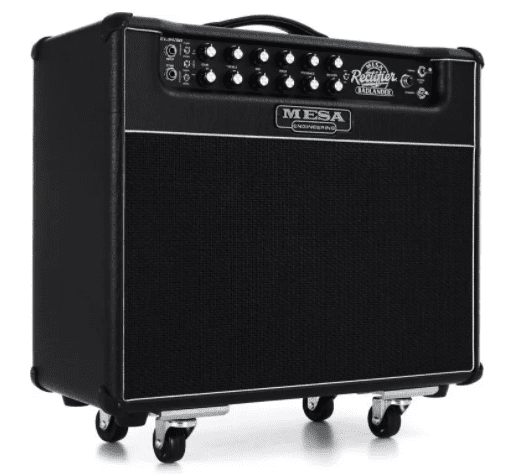
Mesa/Boogie Rectifier Badlander 50 Watt Tube Combo
The ultimate metal amplifier with the convenience of a built in speaker
This is really the final word in combo amps for metal. This is a statement piece, it brings exceptional tonal balance, along with the highest of high end build quality. It offers the performance that pros demand, with the simplicity that gets beginners hooked.
In today’s era of high-quality modelers and profilers, many artists still choose to shun the high-tech gear and stick with analog tube amps. Amongst those in the metal scene, one name stands out above all others… Mesa/Boogie. The Mesa/Boogie Rectifier Badlander 50 blends everything great about the traditional tube sounds with some digital tech for an unparalleled experience.
To dial in metal tones, you need to have the amp in crunch mode. On the crunch channel, there are three settings – Clean, Crunch, and Crush, which offer varying levels of gain. The Crush setting is the big draw here. It brings huge gain, resulting in a punchy yet refined tone that most amps simply can’t touch without the influence of pedals. The EQ was incredibly easy to dial in, too.
One of the neatest features of the Rectifier Badlander is the cab-select function. We were able to use this to simulate eight different cabinets. For a serious musician, combo amps can be limiting as the cab/mic combination also colors the sound, but that’s far less of an issue here. There’s a USB input, so you’re able to upload third-party impulse response cab sims if the built-in models don’t suit your needs.
As you’d expect from Mesa/Boogie, build quality is flawless. It’s a heavy amp at 60lb, but it comes on casters, making it relatively easy to move around. The cabinet is made of Baltic birch, and the single 12” speaker it houses is a Celestion Creamback, a unit renowned in metal circles for its attack sensitivity and touch response.
Verdict: The Mesa/Boogie Rectifier Badlander 50-watt combo is genuinely one of the best amps for sale today – that it also happens to be a weapon when it comes to metal is just the icing on the cake. If you’re looking for straight, high-gain, searing metal tones without the need for pedals, preamps, or any other influence, this is your amp. It’s a serious piece of gear designed for the discerning guitarist.
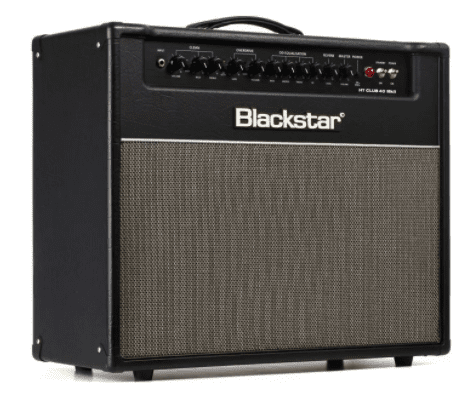
Blackstar HT Club 40 Mark II
Simple design with huge presence and gut punching gain
An underdog from the start, this Blackstar delivered far more in the way of metal tones than any of us could have anticipated. It’s a well made, well equipped combo, and considering its an all-tube model, it’s relatively inexpensive.
There’s nothing particularly exciting about how this Blackstar HT Club 40 Mark II all-tube amp looks, but that’s part of its appeal. This unassuming combo, brought to you by a group of Marshall Amplification breakaways, can deliver soaring metal tones with almost zero effort.
The high gain on the overdrive channel worked well. Unlike the clean channel that only has bass and treble EQ, the OD side has bass, treble, and mids, which let us do some scooping. With the overdrive engaged and the gain cranked, we were chugging right away. The amp has 40 watts of tube power, but we found it to be surprisingly quiet compared to other similarly-sized amps. At higher volume, it did lose some clarity.
The ISF (Infinite Shape Feature) was another great function of this amp. We’ve seen it before on other Blackstar models, but for those who don’t know, it’s an EQ dial that switches the amp voicing between American (counter-clockwise) and British (clockwise). Ultimately, it’s little more than an additional tone control, but it gave us some alternative tones that we otherwise wouldn’t have had.
It offered some great flexibility when it comes to output, insomuch as it can bypass the built-in speaker and play through an external cabinet. We did try out the feature with an Orange 2×12” cabinet but found that it lost a lot of presence. The amp is clearly voiced to the 12” Celestion Seventy 80 speaker that comes in the combo, as it sounded much better before the bypass.
Verdict: Blackstar tends to get more than their fair share of hate online, but the positives about the Blackstar HT Club 40 far outweigh the negatives. For a pretty reasonable price, you’re getting an amp with the capability to dial in multiple voicings with the ISF feature. If you aren’t overly concerned about high-volume cleans, it’s worth your consideration.
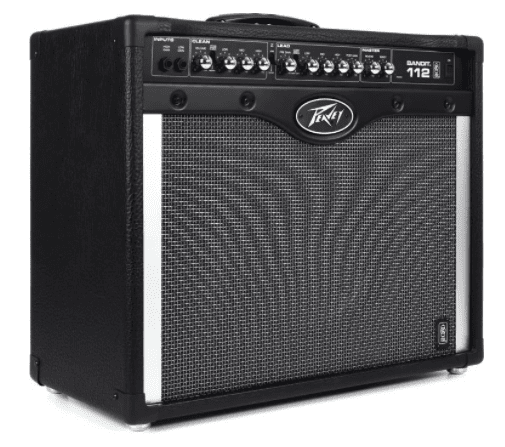
Peavey Bandit 112 1x12” 80 Watt Combo
A modern iteration of an 80s classic
If you’re pining for 80s metal, nothing says that quite like a Peavey amplifier. This is one of the rare solid state amps that comes close to matching a tube amp for tone and performance. It’s built like a tank, and really does offer exceptional value for money.
The Peavey Bandit 112 was the amp to have for aspiring shredders in the ‘80s. Famed for its out-of-the-box metal tones, it was more than capable of matching the tones of the era’s biggest metal stars at a price that wasn’t too far out of reach for the average player.
The Bandit has evolved since its first release. Today’s model, which we were fortunate enough to get onto our test bench, is a genuine competitor in the metal genre. It’s an 80-watt solid-state amp, which gives it plenty of power for small- and medium-sized gigs. And because it has Peavey’s TransTube circuitry, it behaves in much the same way as a genuine tube amp. We found that it doesn’t have the organic tones you’d find in an all-valve model, but it mimics the behavior almost perfectly, so going from distorted to clean happens with a simple rollback of the volume on the guitar.
It features two channels: Clean and Lead. We had to put the Bandit into Lead to get the metal tones we were looking for. On the Lead channel, there are three voicings: Classic, Modern, and High Gain. Classic really didn’t work well for metal, although it did leave headroom for pedals if that’s how you plan to get your tone. We got closer in Modern, but to get the Peavey chugging, we had to push it into High Gain with the post-gain dial cranked.
With the gain set right, the mids scooped, and the treble/bass set to noon and 1 o’clock, respectively, we got some great tones that we were really pretty pleased with. There are separate inputs for the clean and dirty channels, so we didn’t experience any bleed-over between the two. There’s also a boost controller, but after experimenting, we felt we had enough gain without it. With it, things started getting a little muddy.
As the amp’s model name suggests, the Bandit 112 features 1 12” speaker, a Peavey Blue Marvel. It handles high volume well, but response time to changes in attack was noticeably slower than we experienced with the other amps on test.
Verdict: Peavey have always been famous for their metal-voiced amps, but in recent years, it has been overshadowed by some of the other offerings out there. But it’s a powerful solid-state amp that can chug as well as most tube amps at less than half the price in some instances, so the Peavey Bandit 112 does make a great case for your consideration.
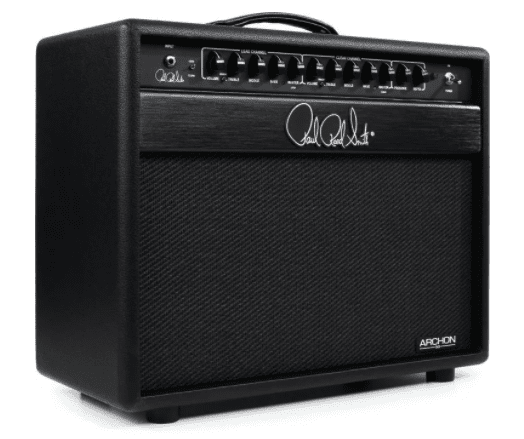
PRS Archon 50 1 x 12-inch 50-watt Tube Combo Amp
Huge gain and incredible control at any volume
An all tube amp that can deliver metal tones at bedroom levels is hard to come by, but if you opt for this PRS Archon 50, that’s exactly what you’ll have. It’s stunning to look at, sounds great, and has easy to manage power.
While mostly known for their guitars rather than their amps, PRS are respected by players for their high-performance amps delivering high gain, with ear-pleasing distortion available on demand. The PRS Archon 50 combo absolutely lives up to this reputation.
Part of what makes this amp great is its simplicity. There’s a 3-band EQ on both the clean and lead channels, and each has its own master volume control. You can tell right away that this amp is geared towards high-gain players by virtue of the fact that the lead channel is the first input, and the clean channel is secondary.
It didn’t take much effort to dial in our metal tones. We had the bright switch set to off, turned the mids to just below noon, with bass and treble around 2, cranked the gain to about 80%, and we were there right away. Even at max gain, the sound remained clear, so fans of the heaviest metal subgenres will likely love this unit. The sound from the Archon 50 is tight and punchy, and in our opinion, it would make for an incredible studio amp.
PRS have equipped this with what they call their “Global Presence” control, which opens the taps somewhat, allowing more gain through and further dirtying the sound (even at bedroom level) without making it muddy. It’s a stand-out feature and really added a lot to the dynamics of this amp.
The internal speaker is 16 ohms, and there are cabinet outputs for 4-ohm and 8-ohm speakers. As you’d expect, it can accommodate a footswitch. There is a single 12” Celestion V Type in the cab, which we actually found to be the weakest part of the whole rig. Upgrading this to something with more bite, like an Eminence Swamp Thang or a Cannabis Rex, would probably put this close to on par with the Mesa/Boogie Rectifier.
Build quality is superb, and looks-wise, it was one of our favorites. PRS always put a lot into their design, and this remains true for their amps. If we have any complaints at all about the construction, it would be the feet. They are quite tall and don’t handle uneven surfaces well. At first, we thought the amp was rattling until we realized it wasn’t on a perfectly-flat floor. After moving it, the vibration disappeared.
Verdict: The PRS Archon 50 narrowly missed out on our Editor’s Choice pick to the incredible Mesa/Boogie Rectifier, but that in and of itself is a huge accomplishment when you consider this amp is around half the price. We loved how easy it was to get this amp chugging, and we loved the variety of textures we got from the presence and depth controls.
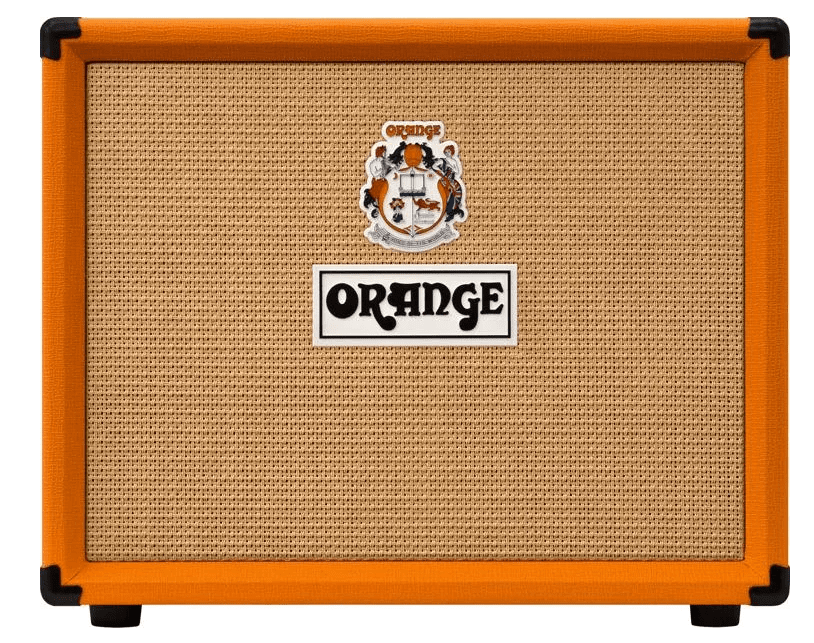
Orange Super Crush 100
Tube like response with the reliability and value that comes with solid state technology
An amp that brings brand heritage, but doesn’t rely on its name to sell units. The Super Crush 100 has earned its spot on this list through its searing, gut punching tones and its ability to retain consistent tone in a range of situations.
In addition to making some of the most recognizable amplifiers on the market (can you say Orange Tolex?), Orange amplification has shaped the sound of many of the world’s biggest rock and metal acts since being founded in 1968. With the Orange Super Crush 100 combo, you’re getting the signature Orange looks along with the authentic tones and the awesome build quality you’d expect from this brand.
Obviously, we couldn’t wait to hear how it sounded with some high gain. After switching to the dirty channel and adjusting the overdrive, we got some thumping metal tones. The Super Crush series is designed with tube-emulation circuitry, which we found mimicked Orange’s valve amplifiers very closely.
One of the most notable points about this amp was just how easy it was to get dialed in. As usual, we started off with the EQ all set to noon and were thrilled with the results. If the flat setting isn’t to your liking, you’ll be pleased to know that the Super Crush has 3 EQ dials (bass, middle, and treble); this let us make all the fine adjustments to the tone that we wanted. We experimented with a few settings and really liked the results across the board, particularly after scooping the mids.
The cab is built from quality plywood and houses a single 12” G12-K150 speaker. The response to changes in attack from this speaker was really excellent. It handled drop-tuning extremely well, and even though we didn’t get a chance to break it in fully, it didn’t seem to lack tonal depth. There are no built-in FX on this model, but it does feature emulated spring reverb and an FX loop.
Verdict: The Orange Super Crush 100 is a great choice if you’re looking for big British tones that can handle everything from classic metal to doom. With 100 watts of power, you’ll have more than enough to gig with. This is a practical choice for any player, whether you’re looking for your first genre-specific amp or to expand a collection. It’s easy to dial in, looks great, and is built to last a lifetime.
How to Choose the Right Amp for You
If you’re shopping for a metal-specific combo amp, it’s important that you’re able to recognize the features that separate amps that are well-suited for metal from those that aren’t.
FX
Effects pedals, especially those for metal, are designed to add gain to the signal before the preamp. Some amps feature effects built into the unit, removing the need for a separate pedal. Having built-in FX can help in cases where an amp lacks the necessary gain to lay metal properly.
Tubes vs. Solid State
Tube amps are treasured for their natural breakup at high gain. When the right combination of preamp and power-amp tubes is used, the resulting distortion can be enough to get the most guttural metal tones imaginable without needing separate FX. The downside is the effect is subdued at more moderate volumes, making it difficult to practice with the right tones at household volumes.
Solid-state amps typically emulate tube tones with the use of electronic circuitry. The vast majority are much less organic sounding than real tube amps, but some exceptions do manage to come pretty close. The big advantage of a solid-state amp compared to a tube model is that high gain can be carried at low volume, meaning you can generally sound the same as you would at performance levels when practicing in your bedroom. Another notable advantage is that they’re less fragile, as there aren’t any delicate (and expensive) glass tubes to break.
Power
Consider how much power you need. If you only ever use your amp for jams, you might be better off looking at something with low power that you can crank right up rather than going with a huge tube model with massive power that you’ll never be able to take advantage of.
Final Thoughts
We really enjoyed testing out all 7 of these amps, so let’s recap our favorites.
Players looking for a great all-rounder that blends price, power, and portability should look to the Marshall DSL40CR. If you’re only in need of a practice or jamming rig and you’re not planning to spend a lot, the Boss Katana 50 MKII is the amp for you. If you’re looking for the best combo amp for metal and you’re not concerned with the price, you need a Mesa/Boogie Rectifier Badlander 50 in your life.


